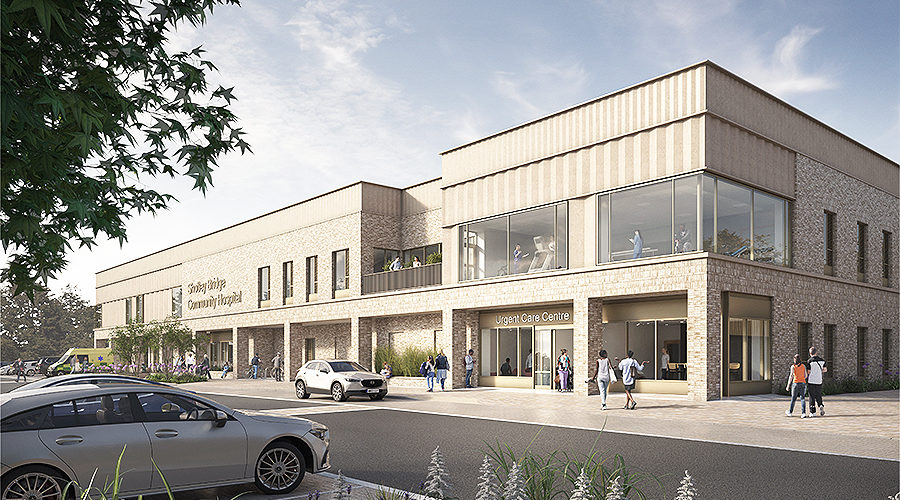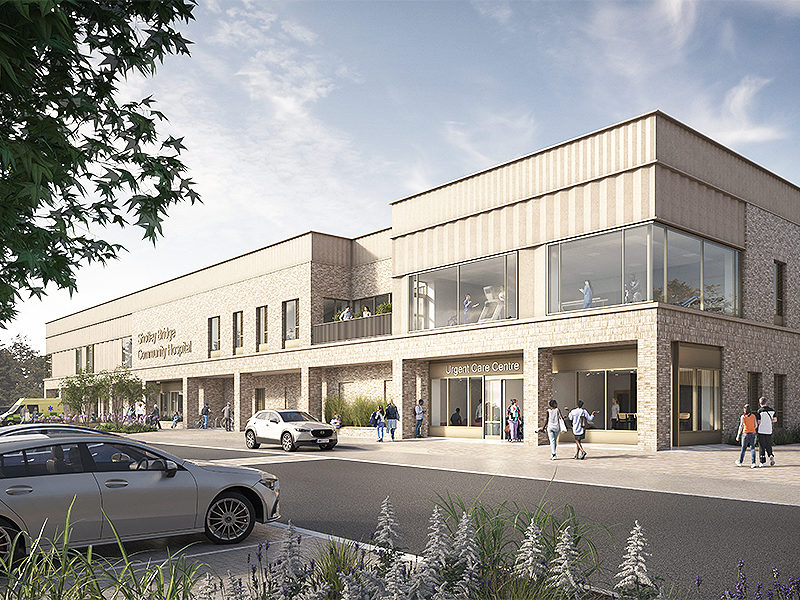The state of healthcare across the UK is the focus of increasingly broad news and political debate. Here, Bob Wills, Director at Medical Architecture, considers some of the current challenges facing the NHS including the increase in backlog maintenance, the availability of capital funding in the face of rising construction costs and the difficult headwind facing the New Hospitals Programme.
Medical Architecture
The current cycle of attention began during the COVID-19 pandemic where the urgent response was rightly praised. Since then, the emphasis has shifted to focus on shortfalls in bed capacity, diagnostic equipment, IT systems and workforce capacity and planning. These systemic problems are illustrated by increased waiting times for treatment, delays at emergency departments, poor access to primary care and dental services, and low staff morale.
Alongside these problems, many of the hospitals and clinics used to provide services are in a poor state of repair. The level of backlog maintenance (the funds required to restore premises to an adequate state), as reported in October 2022, has risen to £10.2bn. This includes significant high-risk elements where there may be danger to life. These problems are longstanding and the consequence of years of short-term planning and underinvestment.
The United Kingdom has had historically low levels of investment in capital compared to similar countries. This has been made worse in recent years by transfers from the capital budget to the revenue budget, which pays for the day-to-day running of the NHS. Much of the data comes from NHS England, however, similar problems are found in Scotland, Wales and Northern Ireland.
With plenty of infrastructure modernisation urgently required, the Government’s room for manoeuvre is very limited. The UK public finances are in poor shape with borrowing already at the highest level for 30 years.
New Hospital Programme
The Government’s headline response has been the promise of new hospitals. This has led to the New Hospital Programme (NHP), a planning and procurement pathway for up to 48 hospitals or substantial hospital infrastructure projects. Progress has been slow with some scope shifting and several already part-completed projects corralled into the programme to provide early wins.
Some smaller hospital projects funded under the NHP are advancing well, including two recently submitted for planning for which we are leading the design, Shotley Bridge Community Hospital and a children and young people’s mental health unit in Dorset.
The challenge of ‘delivery by 2030’ for larger schemes has led to the rapid adoption of innovative approaches, which are still under development. Planned delivery is based on an ambition for speed and cost saving to be achieved through standardised ‘cookie cutter’ layouts and modular offsite construction. The programme flagship, ‘Hospital 2.0’, is expected to be fabricated like Lego, in factories and transported to sites for rapid assembly. Despite the many potential upsides of this approach, there is still a lot of work needed in aligning clinical procedures and pathways, standardising hospital logistical procedures and defining a common staffing model.
The UK Treasury has, not surprisingly, been reluctant to commit long-term capital to the programme and there is no procurement or risk transfer model for private-public partnership whilst the Government is still picking up the pieces from the collapse of the contractor Carillion.
Community health and primary care
An increasingly elderly population with complex needs means that the existing organisation is poorly suited to managing wellbeing. The bulk of patient interactions within the health system occurs outside acute hospital. For example, there are around one million GP appointments each working day. Innovation in primary and community care systems and infrastructure are central to improving productivity and efficiency across the NHS.
An emerging class of primary and community care facilities provide local integrated care, bringing together general practice, geriatric specialities and rehabilitation therapies. These are community-based services supporting people at home and catering for individuals with multiple morbidities, diverting patients from admission to acute hospitals. Functional community health facilitates the discharge of the large number of patients that are occupying beds, but that are ready for rehabilitation and recovery.
An excellent example is the Jean Bishop Integrated Care Centre in Hull. A recent study, led by a team of researchers from the Wolfson Palliative Care Research Centre at the University of Hull, concluded that the facility has led to fewer hospital ‘frequent flyers’, and that frail patients treated here, who could expect to go to A&E more than three times a year, are 50% less likely to need emergency treatment.
Mental healthcare
The successful transformation of mental health services from asylums to a largely community-based service over the last 50 years, masks a shortage of modern facilities for those that are very ill. Shockingly, there are still many facilities with dormitory-style bedrooms, which must be replaced, and a rising demand for specialist and forensic services. The planning and design of modern, safe and secure mental health settings has evolved as a specialised discipline.
Although the costs are comparatively lower than medical settings, the NHS Health Infrastructure Plan identifies psychiatric facilities as a priority. The next few years will see a focus on reprovision of existing mental health inpatient facilities in England, and also Scotland and Northern Ireland.
Within the wider capacity shortfall, there is a particular lack of specialist provision for children and young people, and those with eating disorders and autism. All of these need purpose-designed environments to cater for the specific needs of patients and staff. Where facilities have been built, for example Mitford Autism Unit in Northumberland, post-occupation feedback shows that these new environments are having a positive impact. We were delighted to hear from Ward Manager, Pamela McIntyre, when she reported that: “Staff are witnessing huge impacts on quality of life. Seeing a mother reacting to her son having his first incident-free day in seven years is very rewarding.”
In these types of buildings, overall patient numbers are comparatively low, therefore, commissioning, planning and business cases are carried out on a regional basis. The emergence of Integrated Care Systems (ICSs) in England should work for the development of new facilities.
Intelligent masterplanning
Redevelopment of a major new hospital may cost upwards of £3bn and require an appetite for risk to cater for economic factors and fast-evolving technologies. With uncertainty over the availability of Government capital funding for major projects, health organisations are increasingly exploring how to make the best use of existing infrastructure.
There is a notable shift in sentiment away from short-term expediency where congested hospital sites have become difficult to operate and maintain. There is now recognition that a robust long-term vision is essential to enable opportunistic rapid response where the availability of delegated capital funding is uncertain. Health organisations are commissioning comprehensive plans for the evolution of existing sites, integrating with the cities they serve, mitigating risks and identifying rapid productivity gains.
Intelligent masterplanning using data-rich building information modelling enables clinical activity parameters to be tested against alternative building configurations and phases in real time. Skill and experience are required to identify potential reorganisation options that achieve a better fit of function and fabric.
In the past, treasury rules and health estate reorganisation has prioritised rationalisation and disposal of unused estate. Rationalisation is still important, but the focus is now shifting to improved whole-system performance and pooling of resources through ‘one public estate’ initiatives to deliver complementary functions.
Reuse of assets
With limited scope for major new project investment, there is now a growing appetite for re-evaluating what can be achieved with existing health infrastructure. Not all NHS facilities are appropriate for reuse, so careful appraisal is needed to select the right project. However, given the large amount of poor estate, the potential benefits are significant. There are wider sustainability benefits as this approach reduces waste and capitalises on embodied carbon in the existing fabric.
Modest interventions in unloved but functional hospital buildings can deliver a big impact. Small modifications to structure and services can improve flow and functionality, whilst improvements to lighting and finishes have a direct impact on patient and staff perceptions, improving productivity and experience.
More substantial repurposing of buildings can act as an enabler of change, providing for new models of treatment and care, where the cost and timescale required for new buildings would be prohibitive. These projects are sometimes the most challenging and rewarding. From a technical perspective, a project must meet the equivalent environmental standards of a new building; for the designer, the objective is to provide a step change in environmental quality for the public, patients and staff.
Two recent examples in North Yorkshire, with the redevelopment of Whitby Hospital and Guisborough Hospital, show what can be achieved in our regional communities with modest investment, an integrated approach to healthcare delivery and the strategic reuse of existing hospital infrastructure.
Where now?
The legacy of past underinvestment tells us that continuing with managed decline is an undesirable, risky and expensive option. Despite the poor state of public finances, good custodianship of our healthcare infrastructure goes hand in hand with providing what the public expect; modern and effective health services in buildings that are safe, attractive and a great place to work.
This needs strong leadership, skill and a concerted effort to secure short-term improvements whilst nurturing a long-term positive vision for our healthcare estates. This dual strategy entails building a pipeline of rapid, revenue driven, high-impact improvements alongside strategic plans that will underpin a robust and appealing forward vision. New NHS facilities will integrate sustainable design, modern methods of construction, logistical automation and digital technologies to ensure our healthcare infrastructure is fit for the future.















